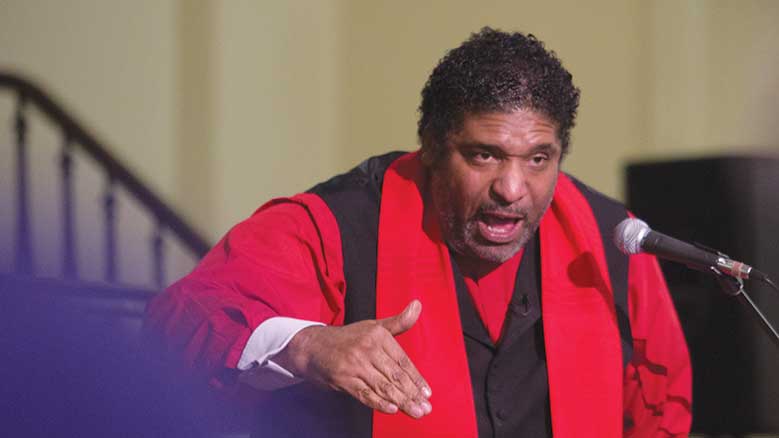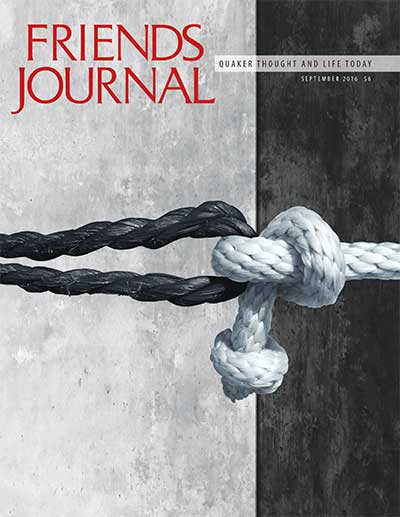
Moral Fusion Politics and Working for Justice
It’s always been one of my great dreams to come and be at a Quaker Friends meeting, even if it meant just sittin’ and bein’ quiet. And that’s because I know enough about history to know about the Religious Society of Friends and the abolition campaigns that began long before the end of slavery in Britain. I know that George Fox, in 1657, challenged those who had Blacks and Indians as slaves, and said, Wait a minute. What about the equality of all people? I know about how Friends and Quakers saw it as their spiritual duty to be abolitionists. They didn’t separate it: I’m spiritual when I’m sitting in the meetinghouse. And then over here, I’m political. They knew your spirituality should inform your politics.
I know that Quakers became so strong in their abolition of slavery that you could be disowned as a member of this particular body for holding slaves. I know that in 1696 William Sotheby demanded a ban on slave ownership and importation; so did John Woolman, in 1754, in his tracts. All of those laid the groundwork for the great abolition movement. I know about one of your writers, Benjamin Lundy, who said, “The end aim of this publication is the total abolition of slavery.” He died in 1839. He didn’t see it, but he sowed the seeds. I know about Lucretia Mott, who was an anti-slavery and women’s rights advocate, which means she also worked with Sojourner Truth and Elizabeth Cady Stanton, and how she said, “If our principles are right, why should we be cowards?”
People talk about Dr. Martin Luther King Jr. and John Lewis and Roy Wilkins and others. But if it wasn’t for the Quaker Brother Bayard Rustin, the 1963 March on Washington wouldn’t have ever gotten out of the gate. If it wasn’t for Brother Rustin, nobody else could handle all those egos and put them in their place. I suspect he wasn’t a quiet Quaker that day! But maybe he was, and it was the way he looked that made them all just say, Wait a minute.
I don’t know what Bayard Rustin said, but he made those folk get together. He brought together those egos and organized and understood that the March had to be more than a one-day event in Washington, D.C. It had to be a call to go back home and continue the work. As Dr. King said, We’ve come here to serve notice now. But we gotta go back to Mississippi, go back to Alabama, go back to South Carolina, go back to North Carolina, knowing that one day, we shall be free.
Rustin said, “My activism did not spring from being black. Rather, it is rooted fundamentally in my Quaker upbringing and the values instilled in me by my grandparents who reared me. Those values were based on the concept of a single human family and the belief that all members of that family are equal.” The wisdom, the insights, and the foundations of your faith are so needed in this moment.
I firmly believe that we are in the midst of a Third Reconstruction in America. If we fully grasp the power of the moral fusion, intersectional movement building that produced the first two reconstructions, we can bring this reconstruction into full existence. If we understand the deconstructive tactics that always begin whenever there is a move to a reawakening to help this nation move a little bit closer to being a more perfect union, we cannot be so much in despair but understand what we must do now.
Many people are saying (and so many of the media are saying), We’ve never seen this before. Yes, we have. Your history knows that. We’ve seen this before.
The First Reconstruction took place in the shadow of slavery and amid the wreckage of the U.S. Civil War. African Americans joined hands with white farmers in the South and some allies in the North. Within four years, black and white coalitions ended up controlling every statehouse in the South. In fact, many of them had majority black legislatures within four years of the end of slavery. They passed the Thirteenth Amendment to the Constitution to end slavery. They then passed the Fourteenth Amendment providing equal protection under the law, from which so many of our rights today for women and immigrants and the disabled come. The Fifteenth Amendment protected the right to vote for men but laid the foundation for the Nineteenth Amendment that would later open up the right to vote for women.
They built the first public schools; they made education a public right. They extended the ballot to all men regardless of color. They talked about labor rights. They guaranteed people protection under the law. All this was happening in 1868: blacks and whites working together. They embraced new rules for the courts, ensuring that blacks could sit on juries and give evidence in the court. They expanded democracy.
After four years of this powerful experiment, Reconstruction began to face immoral, powerful opposition. Many former Confederates saw black citizenship and leadership working with white leadership as inherently illegitimate. First, they went after white people. The Klan was in some ways formed to first attack white people, not blacks. They began to wail against taxes. The first arguments about cutting taxes began around 1872. The argument was, If we cut taxes, then the government can’t keep its promises to the former slave. It couldn’t fulfill the post-slavery economy and lift up those white and black allies working together. They hated public schools and involvement in the court system. They didn’t want black and white children to be educated at the same level. Then they went after the courts. The Civil Rights Act of 1875 made it a felony for businesses to refuse to serve black people. But in 1883 it was overturned by the U.S. Supreme Court.
Opponents of Reconstruction went after the courts and began to put more people on the court who were “conservative,” or rather, “extreme.” Then they went after that ballot box. They didn’t undo the Fifteenth Amendment, but they began to put up all kinds of impediments abridging the right to vote.
You know what their marching orders were? You know what they said? They said, We are the redeemers. Sounds real good, doesn’t it? This is the redemption movement. But when you press that, what did they mean by redemption? They meant redeeming America from black-and-white fusion politics—fusion moral politics that was changing the nation.
Then you get the Second Reconstruction starting in 1954. Blacks, whites, Latinos, and young people began to come together. Christians, Jews, and Catholics were willing to march and suffer, and together they built this new fusion movement. In 1954 the U.S. Supreme Court debated the Brown v. Board of Education case that would desegregate public schools. The NAACP’s lead counsel Thurgood Marshall worked with Jewish and white and black lawyers. But he didn’t just argue the law—he also appealed to morality. He said, The only way the court can agree with this, is that you agree that we must keep the former slave as close to slavery as possible. That was his closing argument. All nine justices—even one former Ku Klux Klan member—voted unanimously for the end of segregation, allowed by 1896’s Plessy v. Ferguson decision.
In 1955, 14-year-old Emmett Till was lynched in Mississippi. It was a reaction, some say, to the Brown decision. His mother Mamie Till made a decision: I’m gonna let everybody see this. I’m not covering my baby. This will be an open-casket funeral. Rosa Parks sees the pictures in Jet, a magazine marketed toward African Americans that was one of the few periodicals to publish the graphic photos of Till’s corpse. Parks went to Highlander Folk School, a Tennessee activist center, to be trained in civil disobedience. When the killers are acquitted, Parks says, We gotta go after Jim Crow. In 1955, she refused to give up her bus seat and sparked the Montgomery Bus Boycott. She sits down, and that allows Martin and Bayard and others to stand up, and we see the beginning of the Second Reconstruction.
And what do we get? We get the March on Washington. We get the 1964 Civil Rights Act and the beginnings of desegregation. We get Medicaid, Medicare, expansion of Social Security, economic opportunities, and the war on poverty. In 1960, 35 percent of American seniors lived in wretched poverty; by 1975, child poverty had been cut in half, and poverty among seniors was reduced by over 60 percent. The war on poverty increased federal funding for K–12 education and higher education. These programs begin to enjoy broad support and are rooted in a moral argument. That’s the Second Reconstruction.
And then what happened? The Dixiecrat extremists revolted. They couldn’t stand it. They turned to violence and terror. They killed Martin Luther King Jr. and Medgar Evers and Viola Liuzzo and James Reeb and many others. They decided, We gotta have another movement now. We had the redemption movement to stop the First Reconstruction. What do we need? Southern strategy. And guess what their mantra was? We must take back America. We must make America great again. We must redeem America.
In the midst of those stories lies a roadmap for today. We must begin to think in terms of building out a Third Reconstruction that I believe has been birthed. The signs are here. The election of President Obama (not his policies because I don’t agree with all his policies), coming from the kind of campaign he ran, broke through in the South. He won in places like Virginia, North Carolina, South Carolina—that’s significant!—and Florida. North Carolina, for instance, had never voted for a Democrat, even a white Democrat, and yet he won in North Carolina. There’s a new electorate: blacks and whites and young people. It’s a demographic shift. Now if 30 percent of unregistered black voters registered in the South and they joined with white progressives and Latinos, the southern strategy is in trouble in Georgia, in Mississippi, in Florida, in Virginia, and in North Carolina. These movements are breaking out all over the place. We can’t rest on our laurels. Young blacks, whites, and Latinos are coming together all over this country. That’s a sign of the Third Reconstruction. You have Moral Mondays, Black Lives Matter, and the environmental movement: these are signs that we are seeing a Third Reconstruction.
It took opponents 14 years to stop the First Reconstruction. To fully stop the Second Reconstruction took from 1954 to 1980: that’s 26 years. I believe those who are the cousins of the deconstructors are trying now to kill this new Third Reconstruction in its infancy, because they know the power we would have if we hooked up and aligned ourselves in this moral fusion, this intersectional movement. I believe we have to build out, to make this Third Reconstruction strong and fully healthy. We need indigenously led, state-based, state government-focused, deeply moral, deeply constitutional, anti-racist, anti-poverty, pro-justice, pro-labor, transformative fusion movement in every state.
My son is an environmental physicist, and he tells me things sometimes. He said to me, “Daddy, if you ever find yourself stranded out in mountainous territory, and you have to walk out,” he says, “Daddy, don’t walk out through the valley.” I said, “Why?” He said, “Snakes live in the valley.” He said, “You might have to burn a little energy, but to get rid of the risk of snakes, climb up the mountain or climb up the hill a way.” I said, “Why’s that?” He said, “Because every biologist knows that there’s something called a snake line. Snakes are cold-blooded animals, they can’t live at higher altitude.” He said, “So if you get above the snake line, you can make it out. Might be hard to get up there, but if you get above there, the snakes can’t destroy you.” Well, I stopped by to tell you, it’s our time to get America above the snake line.
That’s what Quakers were doing when they stood against slavery. They said slavery was below the snake line. Hate is below the snake line. Racism is below the snake line. Homophobia and xenophobia are below the snake line. Greed is below the snake line. Injustice is below the snake line. It’s time for us to raise the moral standard above the snake line.
If we can get above the snake line, the sick will have adequate healthcare, the environment will be protected, the injustices of our judicial system can be corrected. But we’ve got to make that climb above the snake line. We can’t settle for all of this fighting and bickering and anger, this distortion and conning that’s going on. If we get above the snake line, we can reject hate and division and the mean attempts to write people out of the Constitution because of their race, creed, or sexual orientation. If we get above the snake line, we can see all people as God’s creation and members of the human family. If we get above the snake line, our politics can be moral, our language can be moral, and our way forward can be moral. If we get above the snake line, a nation of immigrants that sing “God Shed His Grace On Us” can show grace to immigrants, rather than arresting them and trying to build walls against them and trying to put them out of the country. Justice is above the snake line. Love is above the snake line. Mercy is above the snake line. One nation under God, indivisible, with liberty and justice for all is above the snake line.
So my prayer is that we will refuse to live below the snake line. We’ve got to make this Reconstruction grow to full term, to full life. We can’t allow a snake to bite this reconstruction and cause it to die, so we’re gonna get it above the snake line. Quakers, it’s time to get back into the public square. If you believe that there’s life above the snake line, it’s time to get back in the public square.
While I’m walking to get above the snake line, it might get hard. I might have to go through some spiked teeth that are trying to poison me. But I’m going above the snake line. I’m going above the snake line, and while I’m making my way, I’m gonna say, “Walk with me, Lord. Walk with me, Lord. Walk with me, Lord. While I’m on this tedious journey, going to be above the snake line, Lord, walk with me.” And if God walks with us, we can do just as they did in the First Reconstruction, and just as they did in the Second Reconstruction, we can be the generation that takes this generation above the snake line. It’s our time. It’s our time.









THANK YOU DR. BARBER!!! Someone is finally recognizing the many contributions of Quakers. It is time to start tooting our horn again and working to get above the snake line.
A wonderful treatise and so eloquently said. So many of us are feeling such disquiet and fear that what you have written will hopefully inspire people to share and regroup for the common good. Thank you!
I’m just so excited now about the fight tht I thought I was doing on my own 4 my own ..but I’ve always known it wasn’t about me and my immediate family..its about us all. Thank you so much 4 allowing me to believe in this country once again..I’m all in for the third and final reconstruction of America.
Rev. Barber, thank you so much for sharing “the Light,” in the form of your brilliant, powerful, courageous, spiritual analysis and call to action. I must say, you gotta lotta Quaker in you, sir! I hope your words will be shared by Quakers with millions of their friends of all colors, creeds, and communities. This is precisely the kind of spark needed to ignite a Third Reconstruction. People need to realize that there are no spectators in this crisis. One is either for equal justice under law, or with the snakes. And no amount of denial, rationalization, apologies for racism, or coddling of racists will change that stark reality. We either embrace the ocean of Light, or support the ocean of Darkness. It’s just that simple.